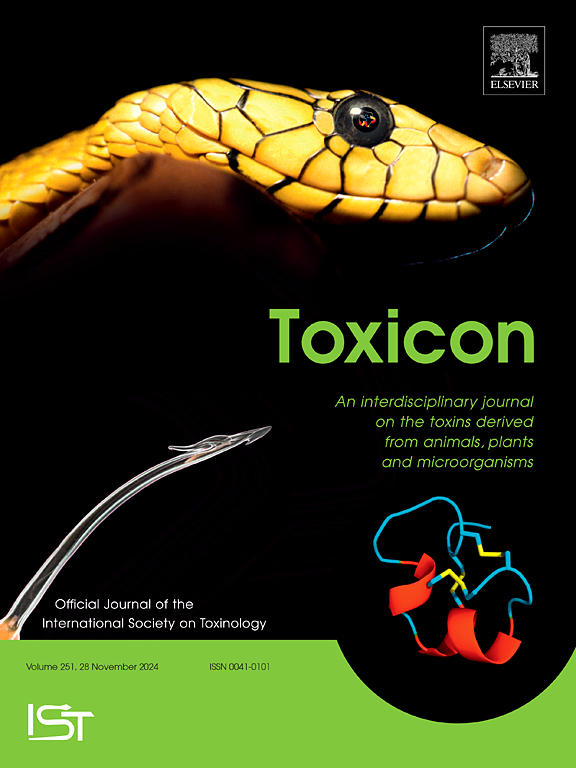Oral Bee Venom as a Novel Therapeutic Approach for Diabetic Nephropathy in Rats: Role of PI3K, AMPK, and VEGF Signaling
IF 2.6
4区 医学
Q2 PHARMACOLOGY & PHARMACY
引用次数: 0
Abstract
Diabetic nephropathy is a significant global health concern. While bee venom has shown potential in treating diabetes mellitus, its efficacy in managing diabetic nephropathy remains unclear. Moreover, the painful nature of bee venom injections besides its possible allergic reaction limits its widespread use. Thus, this study investigates the possible efficacy of oral bee venom administration compared to subcutaneous injection in treating diabetic nephropathy, focusing on the pathophysiological mechanisms involved. Thirty two rats were divided into four groups: normal control, diabetic control, subcutaneous bee venom (0.5 mg/kg daily), and oral bee venom (1 mg/kg in drinking water daily). Diabetes was induced in obese male albino rats using streptozotocin, followed by four weeks bee venom treatment. The present results revealed that the increased fasting glucose, insulin levels, HOMA-IR and serum creatinine in the diabetic control group, were restored to near-normal values with both bee venom-administration routes. Pi3K and AMPK, and the autophagy marker, Beclin-1, were downregulated in diabetic controls. Both bee venom treatments upregulated these genes. Additionally, immunohistochemistry revealed increased eNOS and VEGF in diabetic controls that decreased with both bee venom treatments. In conclusion. Oral bee venom effectively ameliorates diabetic nephropathy in rats through the upregulation of Pi3K, AMPK, Beclin-1, and decreased eNOS, and VEGF immunohistochemistry. Suggesting potential therapeutic applications for oral bee venom in managing diabetic nephropathy, offering a less painful and less allergic alternative to traditional subcutaneous administration.
蜂毒通过PI3K和AMPK通路诱导糖尿病肾病大鼠自噬
糖尿病肾病是一个重要的全球健康问题。虽然蜂毒已显示出治疗糖尿病的潜力,但其治疗糖尿病肾病的功效尚不清楚。此外,蜂毒注射的痛苦性质以及可能的过敏反应限制了它的广泛使用。因此,本研究探讨了口服蜂毒与皮下注射蜂毒治疗糖尿病肾病的可能疗效,重点关注其中的病理生理机制。将32只大鼠分为4组:正常对照组、糖尿病对照组、皮下蜂毒组(0.5 mg/kg / d)和口服蜂毒组(1 mg/kg / d)。用链脲佐菌素诱导肥胖雄性白化大鼠患糖尿病,然后用蜂毒治疗四周。本研究结果显示,两种蜂毒给药方式下,糖尿病对照组空腹血糖、胰岛素水平、HOMA-IR和血清肌酐均恢复到接近正常值。在糖尿病对照组中,Pi3K和AMPK以及自噬标志物Beclin-1下调。两种蜂毒疗法都上调了这些基因。此外,免疫组织化学显示,糖尿病对照组的eNOS和VEGF增加,而两种蜂毒治疗均降低。在结论。口服蜂毒通过上调Pi3K、AMPK、Beclin-1,降低eNOS和VEGF免疫组化,有效改善大鼠糖尿病肾病。提示口服蜂毒在糖尿病肾病治疗中的潜在应用,提供了一种比传统皮下给药更少痛苦和更少过敏的选择。
本文章由计算机程序翻译,如有差异,请以英文原文为准。
求助全文
约1分钟内获得全文
求助全文
来源期刊

Toxicon
医学-毒理学
CiteScore
4.80
自引率
10.70%
发文量
358
审稿时长
68 days
期刊介绍:
Toxicon has an open access mirror Toxicon: X, sharing the same aims and scope, editorial team, submission system and rigorous peer review. An introductory offer Toxicon: X - full waiver of the Open Access fee.
Toxicon''s "aims and scope" are to publish:
-articles containing the results of original research on problems related to toxins derived from animals, plants and microorganisms
-papers on novel findings related to the chemical, pharmacological, toxicological, and immunological properties of natural toxins
-molecular biological studies of toxins and other genes from poisonous and venomous organisms that advance understanding of the role or function of toxins
-clinical observations on poisoning and envenoming where a new therapeutic principle has been proposed or a decidedly superior clinical result has been obtained.
-material on the use of toxins as tools in studying biological processes and material on subjects related to venom and antivenom problems.
-articles on the translational application of toxins, for example as drugs and insecticides
-epidemiological studies on envenoming or poisoning, so long as they highlight a previously unrecognised medical problem or provide insight into the prevention or medical treatment of envenoming or poisoning. Retrospective surveys of hospital records, especially those lacking species identification, will not be considered for publication. Properly designed prospective community-based surveys are strongly encouraged.
-articles describing well-known activities of venoms, such as antibacterial, anticancer, and analgesic activities of arachnid venoms, without any attempt to define the mechanism of action or purify the active component, will not be considered for publication in Toxicon.
-review articles on problems related to toxinology.
To encourage the exchange of ideas, sections of the journal may be devoted to Short Communications, Letters to the Editor and activities of the affiliated societies.
 求助内容:
求助内容: 应助结果提醒方式:
应助结果提醒方式:


